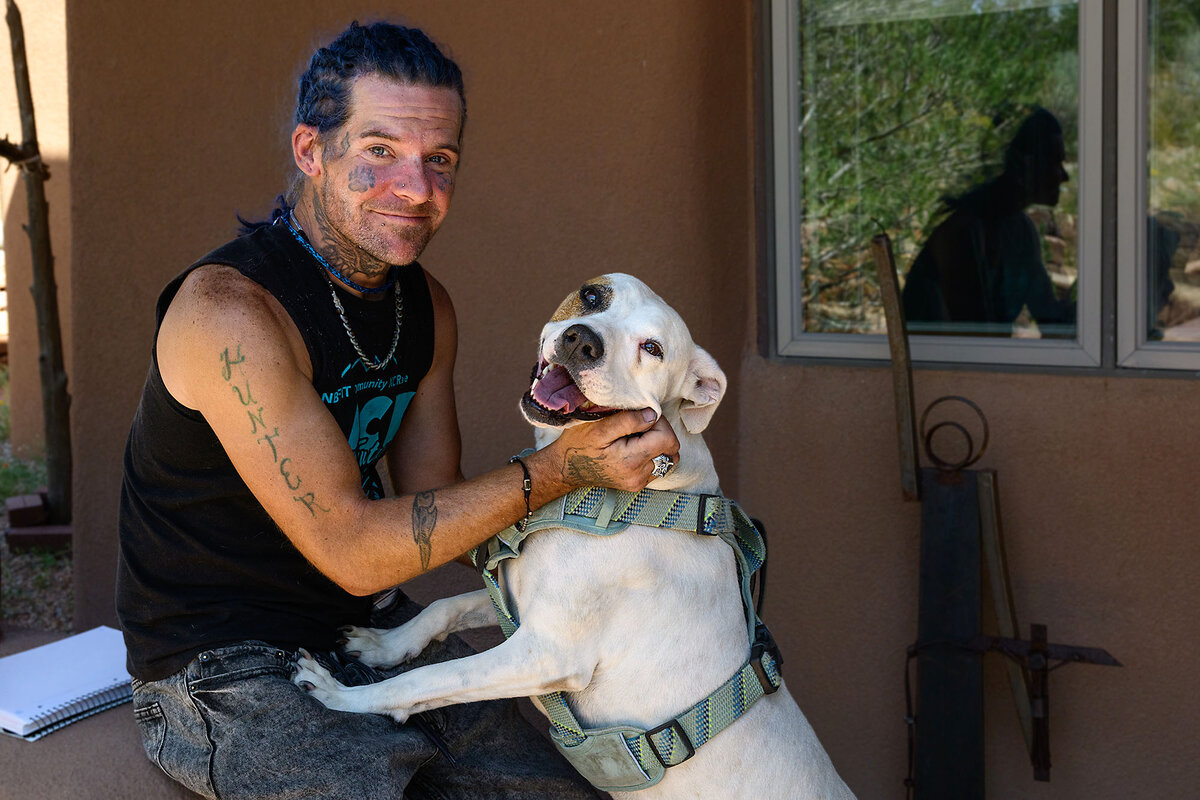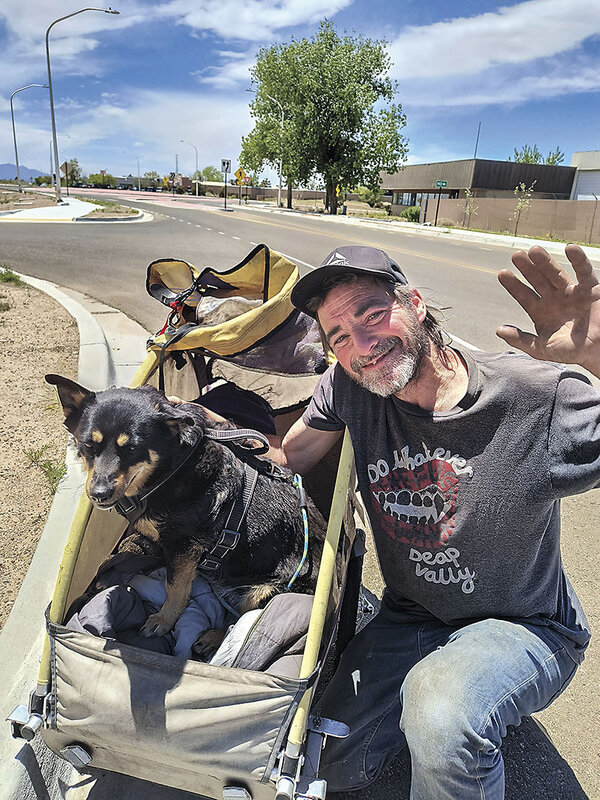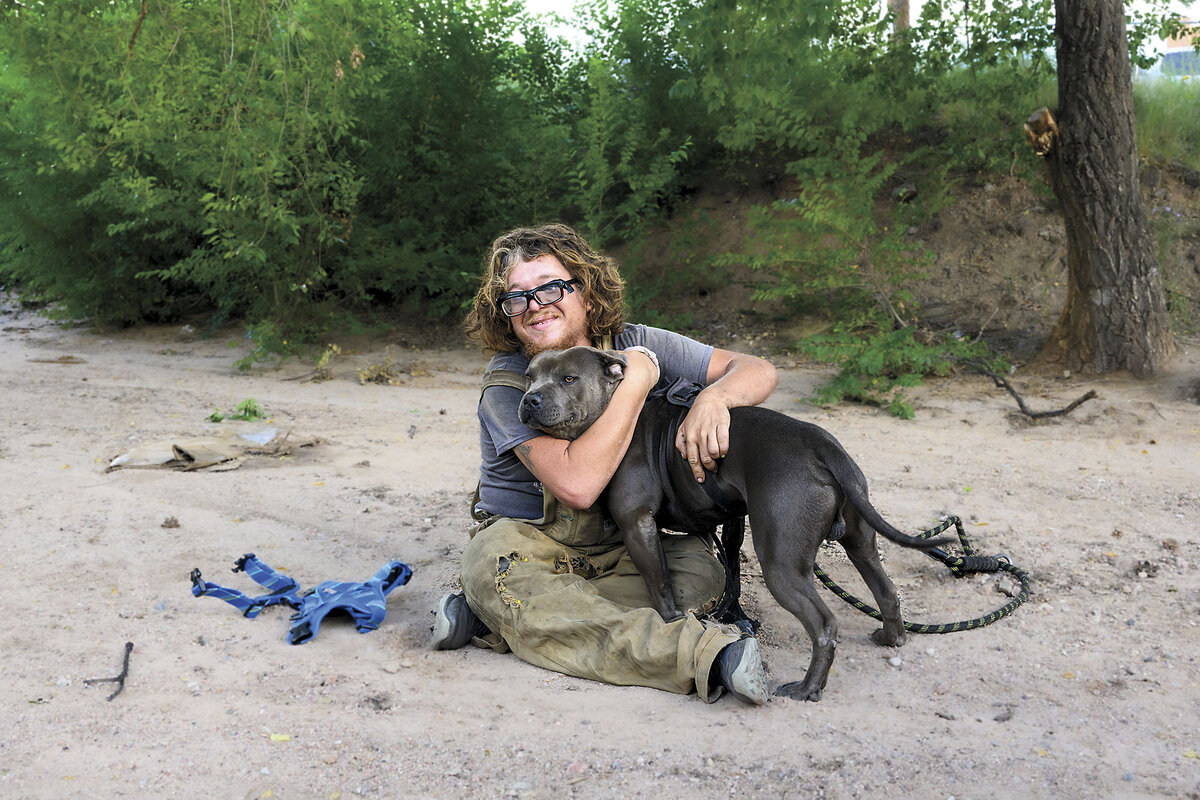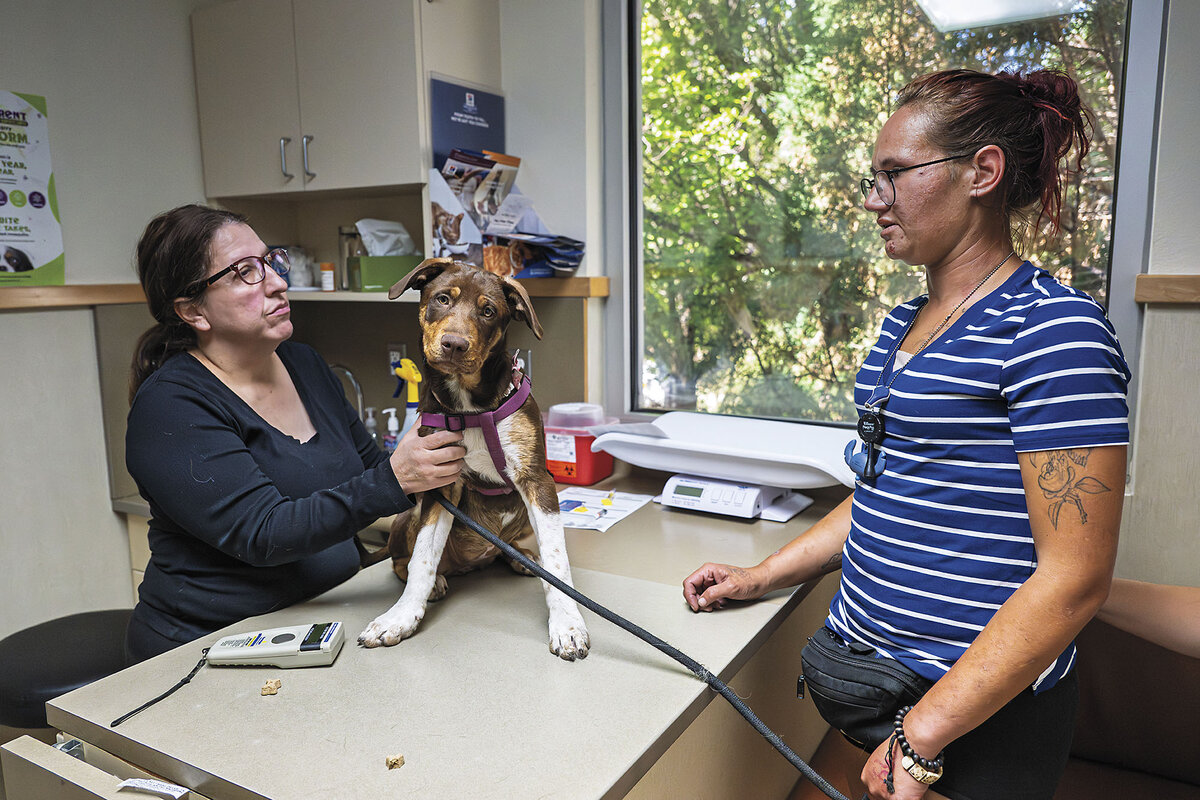Can homeless people care for their pets? A Santa Fe controversy points to solutions.
Loading...
| Santa Fe, N.M.
This past April, social media users shared a video that was said to show a homeless man brutally beating his dog in Santa Fe, New Mexico. Within days, the dog’s owner, Chris McMurtry, began receiving threats from animal-lovers. Some commenters on the local Nextdoor platform suggested that someone should offer to buy the corgi mix, named Desi, while others proposed stealing her, in order to save her life. Within weeks, Desi went missing.
Mr. McMurtry immediately phoned the Street Homeless Animal Project, a nonprofit advocate for homeless people and their pets. ‚ÄúThe worst has happened,‚ÄĚ he said.
As Santa Fe, like many cities across America, grapples with how to address homelessness, tensions are spiking over the welfare of homeless people’s pets. And some residents, frustrated by what they perceive to be abusive and neglectful behavior by some homeless dog-owners, may have decided to take the law into their own hands, police believe.
Why We Wrote This
Human beings have long had special relationships with canine companions. But are the dogs of people without housing cared for? Our correspondent investigates.
But here‚Äôs the thing: The person in the video is not Mr. McMurtry. And, while the man in the footage is evidently inebriated, making strange, contorted motions with his upper body, Desi is seen standing off to the side, wagging her tail, for most of the half-minute clip. According to the head of the Santa Fe Animal Services department, there is no indication in the video or otherwise that Desi was being abused. ‚ÄúThe dog is just looking at him like, ‚ÄėWhat‚Äôs the deal?‚Äô‚ÄĚ says Capt. Amanda Monta√Īo.
When I caught up with Mr. McMurtry one day behind a Dollar Tree store, he was unequivocal: He was there, he says, just off camera, and the man in the video ‚Äúwas not hitting Desi.‚ÄĚ
The Santa Fe Police Department is investigating Desi‚Äôs disappearance as an animal abduction, a misdemeanor theft, and suspects that vigilante dog ‚Äúrescuers‚ÄĚ were involved. Her whereabouts, six months later, remain unknown.
Mr. McMurtry is devastated by Desi’s absence. He has owned Desi for over six years, he explains, adopting her when she was about 8 weeks old from another homeless person who couldn’t take care of her. He hadn’t been looking for a dog, but she quickly became the center of his world.
At one point during our conversation, he breaks down, crying. ‚ÄúI have a big heart, and I love my dog,‚ÄĚ Mr. McMurtry says. ‚ÄúThis is the worst possible thing that could happen to me.‚ÄĚ
Mr. McMurtry takes pride in being ‚Äúa really good dog-owner. I would do anything for my dog.‚ÄĚ But now, he feels, ‚Äúthe whole town is looking at me as a dog abuser. It‚Äôs insane what people were saying.‚ÄĚ Still devoted to Desi, he hasn‚Äôt gotten a new dog. ‚ÄúI have to have closure,‚ÄĚ he says. ‚ÄúI‚Äôll never stop trying to find her.‚ÄĚ
But there‚Äôs not much he can do on his own, and police say there are ‚Äúno new leads‚ÄĚ in the case.
Are homeless people able to care for dog companions?
Santa Fe is home to around 90,000 residents. Official estimates put its homeless population at some 375 individuals, though new data suggests there may be as many as 1,600.
On any given day, it‚Äôs impossible to drive around town without spotting homeless people holding signs on median strips asking for help, approaching shoppers in grocery store parking lots, or hanging out in public spaces. A substantial, though uncounted, number of them have companion animals ‚Äď mostly dogs.
As a lifelong dog-lover who lives near Santa Fe, I often wondered how these animals are doing. Do they have enough food and water? Are they too hot in summer, too cold in winter? Do they have shelter at night? At heart, I suppose, I questioned how well a person who is apparently struggling to meet their own needs could properly care for another living being.
I took an interest in local social media threads that painted the situation as dire. Some posters called for bans on homeless people owning pets, while others accused specific individuals of animal abuse, referring to them as ‚Äúscum‚ÄĚ and ‚Äúevil,‚ÄĚ among other unflattering characterizations. I had no idea whether any of the allegations about the conditions of unhoused canine companions were true, and wanted to find out.
One woman whom I met at a coffee shop, who wished to remain anonymous for fear of local retribution, expressed deep concern for the welfare of the dogs. She described scenes of dogs abandoned for hours while their owners were off somewhere using fentanyl. She named certain homeless people as serial dog abusers. Speaking of many homeless folks, she says, ‚ÄúIf they can‚Äôt take care of themselves, they can‚Äôt take care of an animal.‚ÄĚ The same sentiment is expressed by someone else, word for word, in one of the Nextdoor threads about Desi. On the face of it, this logic made sense.
But then I asked the Animal Services department and the Santa Fe Animal Shelter about a handful of the dogs that are most frequently mentioned in online forums as victims of cruelty. According to their records, which were corroborated by interviews I conducted on the streets, none of the dogs about which I inquired have shown any signs of being abused or malnourished.
One instance of neglect was confirmed by a dog’s owner, Brad Wolleson, who says he was sick one cold winter night and left his dog in the care of a friend. That person abandoned the dog and tied her to a pole in a street median. The dog, Lily, was picked up by a passerby and taken to the animal shelter.
‚ÄúIt was a mistake,‚ÄĚ Mr. Wolleson says with remorse. ‚ÄúI don‚Äôt let other people watch her anymore.‚ÄĚ He says he takes better care of Lily, who looks fit and healthy, than of himself. ‚ÄúShe always has food and water, even if I don‚Äôt.‚ÄĚ
Santa Fe’s Street Homeless Animal Project
Some animal advocates in Santa Fe believe the best way to help these pets is not to rehome them, but to give their owners the assistance they need to care for them. One of these advocates is Karen Cain, who runs the Street Homeless Animal Project.
The back of Ms. Cain‚Äôs white pickup truck is stocked like a dog-centric outdoor specialty store: Most days find her driving around town passing out bags of kibble, harnesses, bowls, and blankets for the pets of homeless people, while also giving tarps, tents, sleeping bags, heaters, and $20 food cards to their humans. If one of these dogs is sick or injured, the project will pay its veterinary bills, also covering the costs of wellness checkups, heartworm prevention, and spaying and neutering. Ms. Cain‚Äôs mission is to ‚Äúprovide support for companion animals of unhoused people.‚ÄĚ
‚ÄúWhen we started back in 1998, it was just about the animals,‚ÄĚ she told me. ‚ÄúNow, it‚Äôs about the ‚Äėfamily‚Äô ‚Äď if a person is not OK, their dog is not OK.‚ÄĚ
Those who believe that dogs can live good lives with homeless owners often point out that having a roof over its head is no guarantee that a dog isn’t suffering.
Taimie Bryant, a UCLA law professor who is deeply engaged with animal rights issues, says that people without housing are subject to a ‚Äúvisibility bias.‚ÄĚ
‚ÄúWe see dogs living on the street who clearly need more than they receive,‚ÄĚ Dr. Bryant says. ‚ÄúBut we don‚Äôt see what‚Äôs going on behind closed doors in many homes where dogs are housed. We can‚Äôt assume that housed dogs are treated well, just as we can‚Äôt assume that unhoused dogs are treated badly.‚ÄĚ
Real-world experience shows how flawed such assumptions can be. One Santa Fe Animal Services officer, Mariah Anderson, says, ‚ÄúWe encounter neglect more often in dogs that live in homes.‚ÄĚ
Mr. Wolleson tells me that he understands why people are concerned about the dogs they see with homeless people. But he says, ‚ÄúIf someone on the street isn‚Äôt taking care of their dog, you can talk to them and they‚Äôll fix it ‚Äď and the ones who don‚Äôt will usually give their dog away. Usually, people listen. It just depends on how you talk to them.‚ÄĚ
Still, that doesn’t mean that cases of abuse or neglect don’t exist on the streets. Some people without housing who own dogs struggle with serious addiction problems, or simply don’t have the emotional bandwidth to consistently care for an animal.
Though Ms. Cain‚Äôs goal is to keep homeless people and their pets together, when she becomes aware of a potentially problematic situation, she alerts Animal Services. ‚ÄúNot everyone should own a dog,‚ÄĚ she says, ‚Äúwhether they‚Äôre housed or unhoused.‚ÄĚ
Decisions about whether to separate a dog from its owner are left to the discretion of Animal Services officers ‚Äď and ultimately would be resolved by a court, if the case gets that far, since, legally, a dog is the property of its owner and can‚Äôt be taken away without due process. While many places have anti-cruelty statutes, Dr. Bryant says that these are ‚Äúvalues expressed in law‚ÄĚ that do not grant dogs any actual rights.
She and other experts working on animal rights issues say the legal terrain is fraught with complexities. Laura Ireland, associate director of the Animal Law and Policy Institute at Vermont Law and Graduate School, points out that conferring rights on animals could have wide-ranging implications, from food production to decisions about veterinary care.
One key question she raises is, ‚ÄúWho gets to speak for the animals? If someone lives in Alaska and owns a husky, great. But what if that person decides to move to a small apartment in southern Arizona? Should that dog be taken away,‚ÄĚ since it might be miserable there? she asks.
It’s possible, Ms. Ireland suggests, that the lives of dogs who belong to people without housing “are actually better than those who are stuck inside alone all day.
‚ÄúIf you‚Äôre looking at the emotional well-being of an animal, the pet who is with their person all the time may be happier,‚ÄĚ she says.
Critics of Santa Fe’s Animal Services division say that, when it comes to the homeless community, animal ordinances are not enforced as vigorously as they should be.
In response, Deputy Police Chief Ben Valdez says, ‚ÄúIt‚Äôd be cruel to have black-and-white enforcement to seize dogs. Some of these pets are the only family people have. And it‚Äôs not good for the animals to be in the shelter ‚Äď it‚Äôs heartbreaking.
‚ÄúOur staff looks at the overall welfare of the dog and what‚Äôs going to be in the best interest of getting the situation addressed,‚ÄĚ he continues. Actual instances of people without housing abusing their dogs are ‚Äúvery rare.‚ÄĚ
Deputy Chief Valdez notes that when a wellness check was performed on Desi after the video was posted, the dog showed no signs of abuse or neglect. ‚ÄúThat guy cared for Desi ‚Äď those two were tight.‚ÄĚ As for the allegations she was beaten, he says, ‚ÄúSomeone made an assumption.‚ÄĚ
Another homeless man about whom assumptions have been made on social media is Brandon Tadlock, a U.S. Army veteran who served in Afghanistan.
When photos of Mr. Tadlock‚Äôs dog Annie were posted online showing some marks on her face, some people leaped to the conclusion that he had deliberately burned her. ‚ÄúBut they were just nibble marks from when she was playing with a puppy,‚ÄĚ he explains to me.
After a veterinarian assessed the dog, she confirmed Mr. Tadlock‚Äôs account in a written report, adding, ‚ÄúAnnie is in great shape and I have met her guardian who loves her and takes wonderful care of her.‚ÄĚ
Some didn‚Äôt want to believe it. ‚ÄúThey called the vet a liar,‚ÄĚ Mr. Tadlock says. ‚ÄúI would never hurt her [Annie]. I love her, and she loves me.‚ÄĚ
Homeless people who have pets are well aware that some in Santa Fe wish they didn‚Äôt. Ciprianna Roybal, who was born here and has been living on and off the streets for a couple of years, owns Little Fatty ‚Äď who is stocky, but not little.
When I met her, Ms. Roybal was also fostering Amor, a 17-week-old puppy who belongs to a homeless friend of hers who ‚Äúhas a lot on his plate,‚ÄĚ she says.
‚ÄúI guess a lot of people think that homeless people shouldn‚Äôt have pets,‚ÄĚ Ms. Roybal says. ‚ÄúBut Fatty keeps me safe. There are a lot of creeps out there.‚ÄĚ
‚ÄúIt‚Äôs none of their business whether we have dogs or not,‚ÄĚ she continues. ‚ÄúIt would be like us saying, ‚ÄėYou shouldn‚Äôt have kids.‚Äô Who are you to say we shouldn‚Äôt have dogs? My dog is as fit as a horse. He eats before I do. I wouldn‚Äôt trade him for anything in the world. He‚Äôs like my kid.‚ÄĚ
It’s not unusual for homeless people to step in and care for dogs that are in tough circumstances, as Ms. Roybal did with Amor and Mr. McMurtry did with Desi.
One man who was camped in an arroyo near a shopping mall and goes by the street name Red Beard says, ‚ÄúWe save dogs.‚ÄĚ His dog, Dazy Duke, whom he adores, ‚Äúwould‚Äôve died from mange and malnourishment if I didn‚Äôt rescue her. She‚Äôs been the best six years of my life.‚ÄĚ
Red Beard‚Äôs friend Matthew, who was wearing torn tan overalls and two pairs of glasses taped together, diagnoses the root of the animosity toward homeless pet owners. With his dog, Guido, by his side, Matthew, who along with Red Beard did not want to share their full names, says, ‚ÄúPeople treat other people like garbage because we don‚Äôt get to know each other.‚ÄĚ
‚ÄúI have to get her back.‚ÄĚ
Many dogs belonging to homeless people spend time, at one point or another, in the Santa Fe Animal Shelter. Most commonly, they’re taken in when their owners are incarcerated, typically for trespassing or for failure to appear in court.
Since they are their owners’ property, the shelter must return them, unless Animal Services or the courts intervene. If a person without housing can’t afford to pay the shelter fees, the Street Homeless Animal Project, known as SHAP, will cover them. This raises the ire of detractors, who think the dogs would be better off if they were adopted out to owners with homes.
The senior director of operations at the Santa Fe Animal Shelter, Dylan Moore, believes that, in most cases, it is in the best interest of dogs to be reunited with their owners, even if they don’t have a home.
‚ÄúNot all dogs can adapt to a new routine after being on the streets for some time,‚ÄĚ says Mr. Moore. ‚ÄúCan someone adopt them and then leave them in the house and go to work?‚ÄĚ Many of these dogs, he adds, respond poorly to being in the shelter, and behave in ways that make them less likely to be adopted.
‚ÄúThese dogs stay in the kennel longer. They decompensate, and can spiral down into a welfare concern,‚ÄĚ Mr. Moore says. ‚ÄúA lot of them face a much higher percentage of euthanasia. If my choice is to expose a dog to more shelter time or euthanasia, I don‚Äôt know why I wouldn‚Äôt give the dog back to an unhoused person, especially if there is support for them like SHAP provides.‚ÄĚ
Mr. Moore also speaks of the ‚Äúvacuum effect.‚ÄĚ If you take a dog away from a person without housing who wants a companion, ‚Äúthey‚Äôll just get another one. And it‚Äôll probably be unvaccinated, and then I‚Äôm concerned about it having puppies. But our ability to help them is diminished, because they won‚Äôt trust us anymore.‚ÄĚ He has concluded that if you want to help homeless people‚Äôs dogs, ‚Äútaking them away is not the answer.‚ÄĚ
Of course, this is precisely what authorities believe rogue actors decided to do with Desi.
Mr. McMurtry is hoping that whoever has her will learn the truth about him and return her. ‚ÄúI have to get her back,‚ÄĚ he says. ‚ÄúThinking that she thinks I abandoned her is crushing.‚ÄĚ













